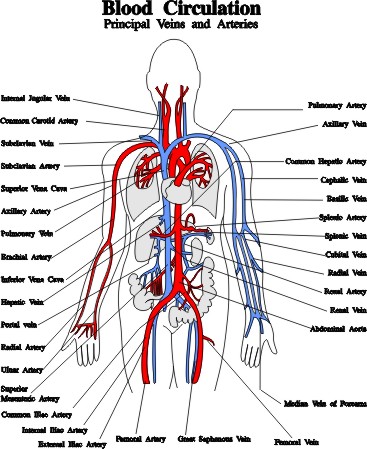55 Anatomy Of Human Body Arteries And Veins
The pulmonary arteries carry oxygen-poor blood to the lungs whereas the pulmonary veins carry oxygen-rich blood from the lungs to the left heart. Each artery is a muscular tube lined by smooth tissue and has three layers.
Blood Vessels Arteries Capillaries Veins Vena Cava Central Veins Lhsc
The anatomy of the veins of the heart is very variable but generally it is formed by the following veins.

Anatomy of human body arteries and veins. The arteries are the blood vessels that deliver oxygen-rich blood from the heart to the tissues of the body. This is an online quiz called Arteries and Veins of the Human Body There is a printable worksheet available for download here so you can take the quiz with pen and paper. The only exception are the pulmonary veins which carry oxygenated blood from the lungs to the heart.
The pulmonary arteries are more like veins anatomically. The iliac femoral popliteal and tibial calf veins are the deep veins in the legs. Arteries carry oxygenated blood to the organs and limbs while veins carry the deoxygenated blood back to the heart for re-oxygenation.
This quiz has tags. Blood vessels are often named after either the region of the body through which they carry blood or for nearby structures. The oxygen-rich blood is then returned to the heart via the pulmonary veins.
They have relatively thin walls reflecting the fact. The veins contained blood -- purely corporeal fluids of the body -- while the arteries a mixture of pneuma and blood an indication of their connection to the spiritual as well as the material. ClassificaonofArteries ElascArteries Conducngarteries AortaBrachiocephalic CommonCarod Subclavian VertebralPulmonaryCommon Iliac.
Because arteries are moving blood being pumped out by the. 4 rows Major arteries. Arteries capillaries and veins.
The great cardiac vein the middle cardiac vein the small cardiac vein the posterior vein of the left ventricle and the vein of Marshall. Heart veins that go into the coronary sinus. Pulmonary arteries carry blood from the heart to the lungs where the blood picks up oxygen.
Pulmonary arteries and systemic arteries. Veins in blue are the blood vessels that return blood to the heart. Arteries in red are the blood vessels that deliver blood to the body.
They work to carry blood away from the heart. In contrast veins carry blood back to the heart. Anatomy of the heart coronary CT - Interactive atlas of the human body using cross-sectional imaging In this interactive anatomy atlas of the human heart the anatomical structures are visible on a contrast materialenhanced computed tomography CT of the heart and coronary arteries.
All the required arteries and veins on the pancake man. They were associated with different principal organs as well namely the liver with the veins and the heart with the arteries. There are two main types of arteries.
The Function of Arteries and Veins While both arteries and veins are blood vessels they are quite different. The head and neck are comprised of many structures that are supplied and innervated by arteries veins and nerves found in this region of the body. For example the brachiocephalic artery carries blood into the brachial arm and cephalic head regions.
One of its branches the subclavian artery runs under the clavicle. Deep veins located in the center of the leg near the leg bones are enclosed by muscle. By definition an artery is a vessel that conducts blood from the heart to the.
Systemic arteries deliver blood to the rest of. Blood Vessels Arteries Veins and Capillaries The cardiovascular vessels function as closed tubular network to propel a viscous fluid blood throughout the body via a combination of positive and negative propulsive pressures in the arteries and veins respectively. The largest artery in the human body is the aorta which is attached to the left ventricle of the heart muscle.
As oxygenated blood flows through the aorta it begins to move into a network of smaller arteries called arterioles and capillaries. Arteries are a type of blood vessel. There are three major types of blood vessels.

